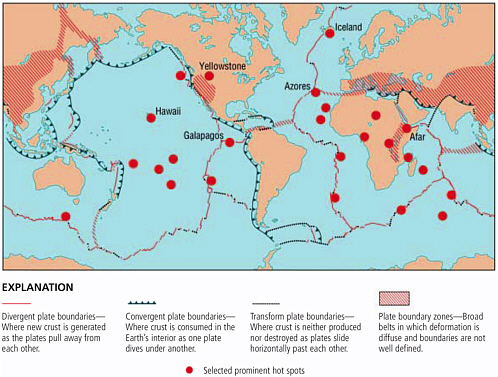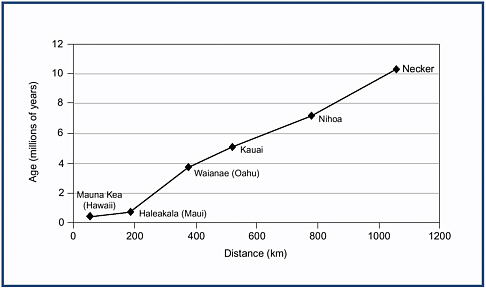earth’s crust have helped create geological formations, such as the hot spot beneath Yellowstone National Park that heats the park’s hot springs and geysers. The movements of tectonic plates have had profound effects on oceanic circulation and climate—the movement of Antarctica toward the South Pole over the last 30 million years led to the formation of the southern ice cap and a gradual cooling of the planet. Similarly, the theory of plate tectonics explains many other geological features (see Figure 8). The bend in the Hawaiian archipelago past Kure Atoll, for example, appears to have resulted from a change in the direction of movement of the Pacific Plate about 43 million years ago combined with movement of the hotspot beneath the archipelago.

Figure 8
The Hawaiian islands are near the center of the Pacific Plate, which is moving toward the northwest as material is added to the plate from the midocean ridge off South America. (Diagram courtesy of U.S. Geological Survey.)
The Evolution of Life on Earth Set the Stage for Evolution in Hawaii
The history of the Hawaiian islands constitutes a very late chapter in the story of life’s history on earth. The oldest member of the Hawaiian archipelago still above water, Kure Atoll, formed about 30 million years ago. The age of the earth, which has been estimated by measuring the amounts of various radioactive elements in its crust and in meteorites, is about 4.6 billion years—more than 150 times the age of Kure Atoll.
The first living things appeared on the earth surprisingly early in its history. Traces of ancient organisms have been found in rocks that are more than 3 billion years old. Biologists do not yet know how the first living
things formed. But they have identified and replicated several chemical processes that could have created the complex carbon-based molecules necessary for life, and they are investigating hypotheses about how these molecules could have come together in assemblages that could make copies of themselves.
Evolution must have been a part of life from the very beginning. The mechanisms that copy the genetic material in cells are not 100 percent accurate. Thus, as the first primitive cells multiplied, they would have begun to produce variants, some of which would have had advantages over their predecessors. Expanding populations of cells also would encounter new environments, which would favor variants that could survive and produce more offspring in the new conditions. In this way, living things diversified over time and took advantage of a growing number of different ecological niches.
Over the billions of years of earth’s history, several important evolutionary milestones have occurred:
-
The appearance of eukaryotic cells more than a billion years ago resulted in organisms with traits not found in earlier prokaryotic cells, since the development of cellular organelles (such as a membrane-bound nuclear envelope) enabled cells to be larger and more complex.
-
Similarly, the evolution of multicellular organisms with cells specialized for particular tasks gave rise to new kinds of organisms with novel forms and functions.
-
The ability to grow hard shells, which appears to have evolved about 570 million years ago, led to the appearance of a variety of new species of animals, with some lines of organisms flourishing and others dying out.
-
The evolution of plants and animals that could live exclusively on land, beginning about 400 million years ago, led to a further diversification of forms and functions. Vascular plants, for example, developed true leaves that enabled more efficient photosynthesis, stems to support the leaves, and roots to anchor the plant as well as to absorb water and nutrients from the soil.
-
The first reptiles, birds, and mammals evolved between about 300 million and 200 million years ago, so that for the first time in earth’s history the surface of the planet was occupied by a wide range of large terrestrial animals.
-
The extinction of the dinosaurs about 65 million years ago enabled mammalian species to expand into a range of ecological niches from which they were previously excluded.
About 30 million years ago, as what is now Kure Atoll was being formed, the world was acquiring many of the characteristics we recognize today. The continent of Antarctica had separated from South America and was moving toward its present location. The resultant cooling of worldwide temperatures produced a new type of vegetative zone in higher latitudes, a temperate mixed woodland similar to the forests of Canada and northern Europe today. Species with distinct similarities to modern dogs, cats, camels, pigs, and deer appeared about this time. In the northern latitudes, many species of primates went extinct as the climate cooled, but in the tropics several evolutionary lineages of primates survived. Millions of years later one of these lines would give rise to gorillas, chimpanzees, and human beings.
When each new Hawaiian island rose above the waters of the Pacific, it was as hot and lifeless as the surface of the early earth (see Figure 9). But it did not remain barren for long. As soon as the lava cooled, it was colonized by spores of algae, mosses, and ferns carried on the wind from other islands and from distant continents. In addition, some birds, bats, and insect species are capable of
|
Panel 1 Many observers of the Hawaiian islands, including the original Polynesian colonists, have concluded that the northwestern islands are older than the southeastern ones because they are lower, more eroded, and no longer volcanically active. According to Hawaiian legend, for example, the goddess Pele moved successively from the older islands to the newer ones, creating new volcanoes on each island in an effort to escape the wrath of her sister Namaka. With the development of potassium-argon radioactive dating in the 1960s, geologists were able to determine the actual ages of each Hawaiian island. For example, one comprehensive set of measurements has produced the following ages for the volcanoes on different islands:
|
||||||||||||||||||||||||||||||||||||||||||
|
If the ages of the islands are plotted against their distance from the currently erupting volcano on the Big Island of Hawaii, the following graph results:  This graph supports the hypothesis that the Hawaiian archipelago formed as the Pacific Plate moved at a relatively constant rate over a hotspot that is currently located under the Big Island. As the plate moved to the northwest, islands moved away from the hotspot and began to erode and subside while new islands were created over the hotspot. This graph also can be used to calculate the rate at which the Pacific Plate is moving. Necker Island is now about 1,050 kilometers (650 miles) from the Big Island, so the Pacific Plate must have moved that distance over the past 10.3 million years. This rate of movement is equivalent to about 10 centimeters (4 inches) per year. |




